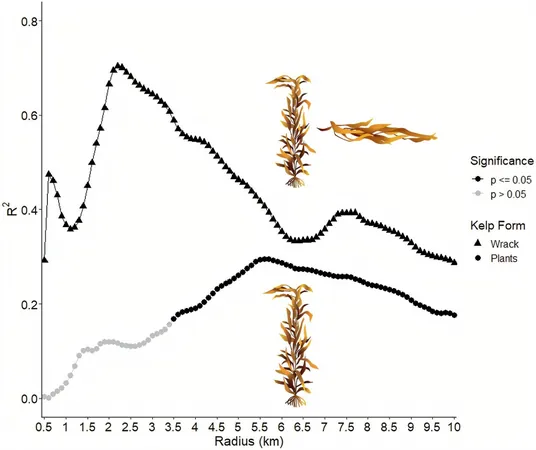
Revealing Secrets of Kelp Forests: How They Nourish Our Beaches!
2025-09-15
Author: Emily
Kelp forests may seem fleeting, but their impact is anything but temporary. This fast-growing giant seaweed thrives in the ocean, creating crucial habitats for fish, invertebrates, and even marine mammals. But its significance extends far beyond the water—when kelp fronds wash ashore, they play an essential role in local beach ecosystems, feeding invertebrates and forming the backbone of sandy beach food webs.
The Mystery of Kelp and Beach Connectivity
Despite knowing that these underwater forests connect with nearby beaches, researchers have struggled to understand how far-reaching this connection truly is. Kyle Emery, a researcher at UC Santa Barbara's Marine Science Institute, stated, "We know there’s a link between the kelp forest and the beach, but the spatial scale of that connection was unclear." Now, his team is uncovering this relationship through novel research published in the journal *Communications Biology*.
Unraveling the Science Behind Kelp Dynamics
Using data collected from the rich kelp forests of the Santa Barbara Channel, Emery and his colleagues are analyzing the interactions between kelp and nearby beaches. Their findings promise to enhance our understanding of habitat conservation and recovery, especially in light of the environmental pressures facing coastal areas.
Kelp: An Ever-Changing Foundation Species
Unlike the stable foundation offered by trees in forest ecosystems, kelp forests fluctuate dramatically. Variables such as temperature, pollution, grazing, and wave action cause these underwater landscapes to ebb and flow throughout the year. This variability complicates efforts to decipher how beach ecosystems relate to kelp forests, often represented by kelp wrack—pieces of kelp that wash up on shore.
Linking Kelp to the Beach Ecosystem
Emery's team aimed to quantify the spatial relationship between kelp found on beaches and that in the kelp forests. They gathered extensive data from the Santa Barbara Coastal Long-Term Ecological Research site, tracking kelp distribution along the coast over more than five years. By surveying beaches within 25 kilometers of kelp forests and conducting regional studies up to 100 kilometers, they gained valuable insights.
New Findings: Local Connections Matter Most
The results were eye-opening. The connectivity between kelp forests and nearby beaches is primarily local, meaning beach ecosystems within 10 kilometers of kelp forests benefit the most from this subsidy. Saying it loud and clear, Emery noted, "This highlights the importance of kelp forest health for both structure and function of nearby sandy beach food webs."
Winter's Role in Kelp Connectivity
Interestingly, the study found that this connection is particularly strong during winter months. Intense storm and wave activity limits the availability of wide beaches to receive kelp wrack, making the connections even more crucial during that time.
Implications for Conservation Efforts
These revelations have significant implications for conservation strategies. Not only can researchers identify biodiversity hotspots along the coast, but protecting kelp also encourages the health of adjacent beach ecosystems. There are ongoing efforts to leverage kelp in a blue carbon strategy aimed at carbon sequestration, but understanding the fate of dislodged kelp is vital for effective carbon management.
Future Researchers Set to Dive Deeper
The research team plans to further investigate this intricate relationship, aiming to track kelp's journey from ocean depths to sandy shores through tagging initiatives. By continuing this work, they hope to deepen the understanding of the dynamic interplay between kelp forests and beach ecosystems.
This groundbreaking study, conducted by a team including researchers from UCSB and UCLA, shines a light on the vital roles both kelp forests and beaches play in maintaining oceanic biodiversity.









 Brasil (PT)
Brasil (PT)
 Canada (EN)
Canada (EN)
 Chile (ES)
Chile (ES)
 Česko (CS)
Česko (CS)
 대한민국 (KO)
대한민국 (KO)
 España (ES)
España (ES)
 France (FR)
France (FR)
 Hong Kong (EN)
Hong Kong (EN)
 Italia (IT)
Italia (IT)
 日本 (JA)
日本 (JA)
 Magyarország (HU)
Magyarország (HU)
 Norge (NO)
Norge (NO)
 Polska (PL)
Polska (PL)
 Schweiz (DE)
Schweiz (DE)
 Singapore (EN)
Singapore (EN)
 Sverige (SV)
Sverige (SV)
 Suomi (FI)
Suomi (FI)
 Türkiye (TR)
Türkiye (TR)
 الإمارات العربية المتحدة (AR)
الإمارات العربية المتحدة (AR)